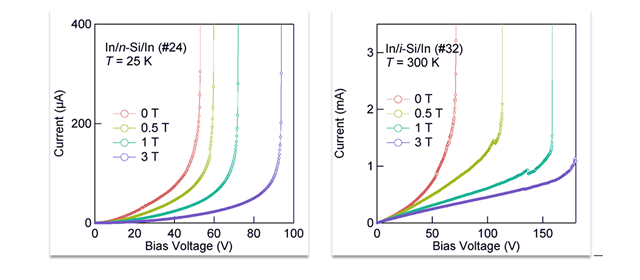New Feature of the Semiconductor Leader: Large Magnetoresistance in Silicon
Because silicon is one of the most intensively studied materials, on which the modern technology has been founded, one might think that no phenomenon remains to be discovered in it. Nevertheless, here, we report a new property of silicon; in a high electric field silicon shows large positive magnetoresistance between 0 T and 3 T more than 1,000 % at room temperature and 10,000 % at 25 K (see Figures in the bottom). The experiment on the lightly doped silicon reveals that when the carrier density decreases below ~1013 cm-3 the magnetoresistance exhibits linear dependence on the field between 3 T and 9 T in high electric fields. We propose that because of the quasi-neutrality breaking in the space charge effect, where no sufficient charge is present to compensate the electrons injected into the device, the electron motion becomes correlated with each other via the unscreened Coulomb interaction and thus the inhomogeneity is induced in silicon, yielding the unconventional non-saturating magnetoresistance as in the inhomogeneous semiconductors.

While large positive magnetoresistance at room temperature was achieved in the metal-semiconductor hybrid devices, it is now realized in a simpler structure in a way different from other known magnetoresistive effects. This novel effect can be utilized to develop new magnetic devices from silicon, which is expected to further advance the current silicon technology.
The present work was partly supported by KAKENHI, ICR Grants for Young Scientists, Kyoto University Global COE Program, Asahi Glass Foundation, and the Sumitomo Foundation.
“Large Positive Magnetoresistive Effect in Silicon Induced by the Space-Charge Effect”
by Michael P. Delmo, Shinpei Yamamoto, Shinya Kasai, Teruo Ono, and Kensuke Kobayashi
Nature, 457, 1112 (2009).